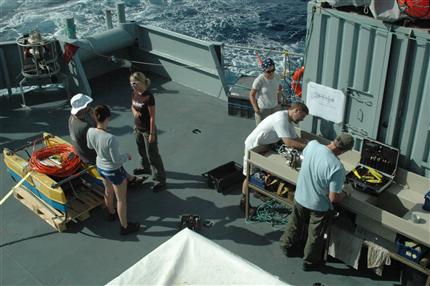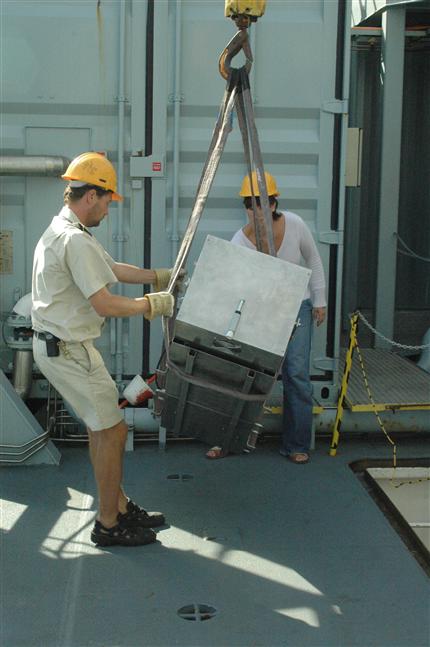On to Hobart - and news from the Explorers of the interior.Newsletter 16: The seventh leg of the cruise, from Broome to Perth, has been accomplished and the eighth leg has just begun. Last week’s rest in Perth was needed. Since VÆDDEREN left Cape Town on 18. October, she made only one short stopover in Broome.
Dato 24.11.2006
Researchers joined the ship and straight away made preparations on board for the eighth leg. Meanwhile, off duty crew and researchers enjoyed some free time.

Foto: Anne Sofie Berendt
Setting up on board
On Tuesday pupils from East Fremantle Primary School visited the ship and this was followed on Wednesday by a meeting between Galathea 3 researchers and some of their counterparts from Western Australian universities. Local and Galathean scientists lectured and discussed their specialist topics. These meetings between Galathea 3 and local scientists are held wherever possible along the way, reinforcing the international network that characterises modern research. Denmark stands to gain from this and naturally plays a part in it too. The open ship has similarly become a tradition whenever VÆDDEREN is in port. Danish people who have settled in this part of the world were welcomed on board on Wednesday.
Land-based research news
Meanwhile botanist Axel Dalberg Poulsen arrived on the island of Makira in the Solomon Sea. As a senior researcher at the Royal Botanic Garden in Edinburgh, Axel is here to study new types of ginger in the Solomon Islands. Even before his arrival, people had heard of him: national radio had interviewed him about the field studies he is conducting for Galathea 3. Many in the country town of Kirakira know him and what his work entails. Read more about the project here.
The internationally renowned ornithologist, Professor Jon Fjeldså from the Zoological Museum also landed on the Solomon Islands. His aim is to make DNA analysis of birds in this area. The Zoological Museum already owns the world’s largest collection of DNA material relating to birds, but there is still a lack of samples from the Indo-Australian islands. Studying the bird life of this region will be immensely valuable for the development of biological typology and our understanding of the way in which new species appear. The Danish newspaper Jyllands-Posten’s Galathea 3-web page features this project (link in danish). Read more about the project here.
Photos from inland research projects are on their way and will be posted on the Galathea website soon.

Foto: Anne Sofie Berendt
Equipment is prepared for the next leg of the journey
Carbonate reefs tell of the past
The weeks to come will see the deployment of VÆDDEREN’s advanced geological equipment. Associate Professor Mads Huuse from Aberdeen University and his team of 15 researchers will be investigating cool-water carbonate mounds in the Great Australian Bight. Carbonate sediments can provide clues to sea currents and changing climatic conditions in this area over the past two million years. At the same time, they have significance for research into analogous mounds which have recently been found to exist in the Danish Chalk Group which borders the North Sea basin. Investigations will be in the form of seismic profiling, sediment and water sampling, measurement of currents and filming of conditions on the ocean floor. More can be found on this project by following this link.
|